



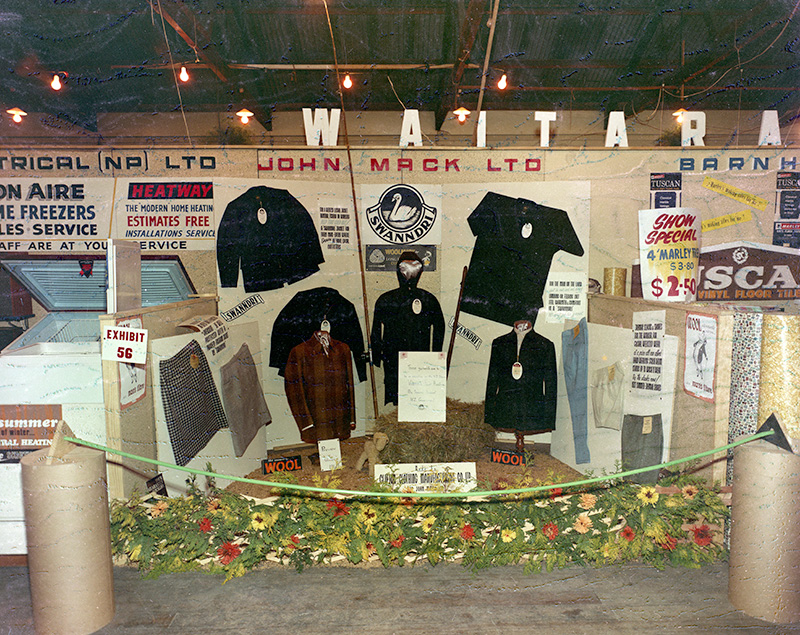

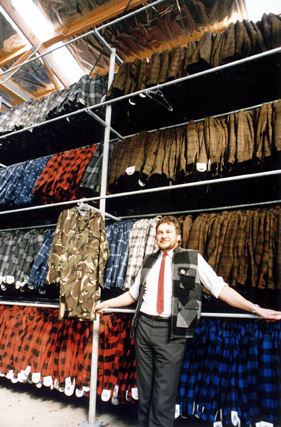
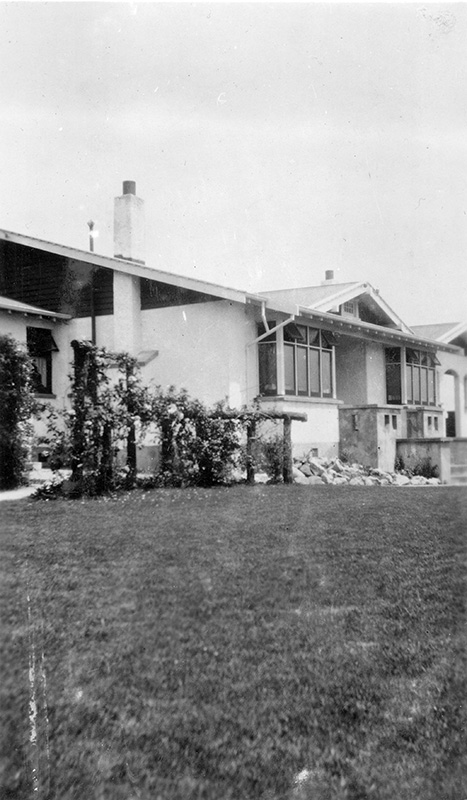
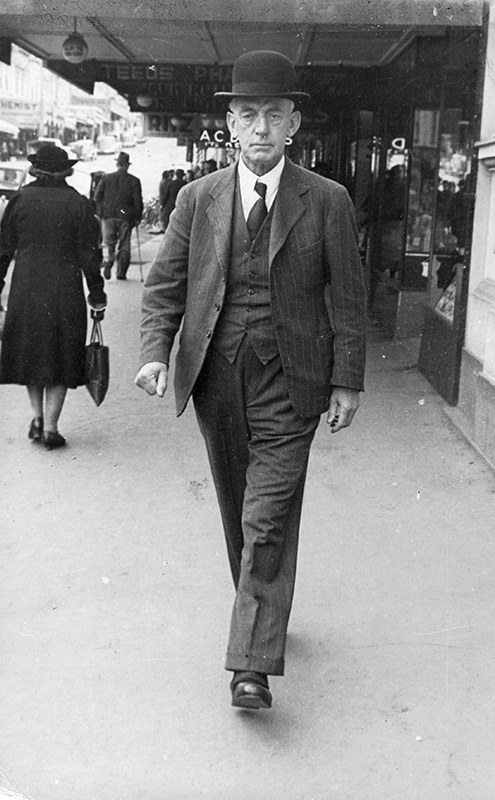
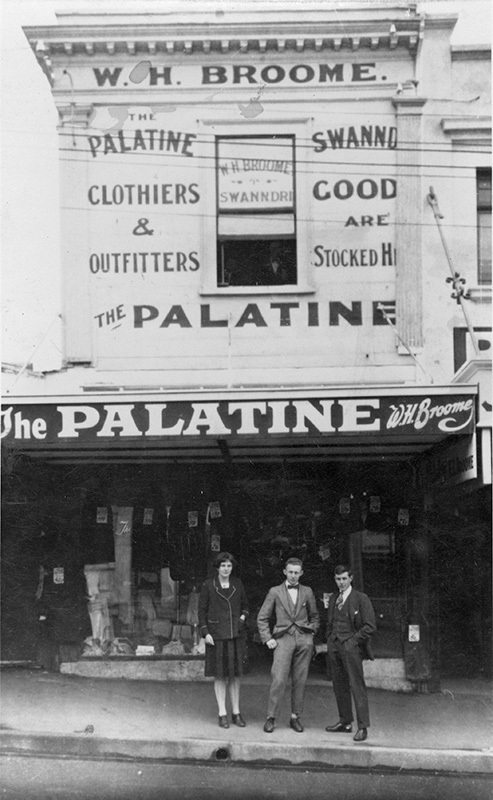
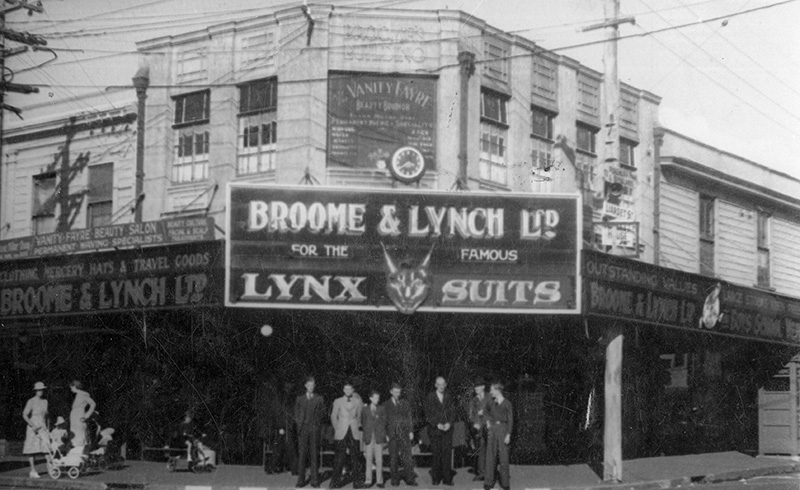
There's not much Bob Bowler doesn't know about Swanndris, despite the fact that he's never owned one in his life. His grandfather was the first man in New Zealand, and the world, to produce the rugged, weatherproofed bush-shirt that would stand up to all the rigors and demands of an outdoor working life and become as iconic in this country as an All Black jersey.
Bob's grandfather, William Henry Broome, was born in Leek, Staffordshire, England in 1873. The fifth child of a shoe manufacturer. He arrived in New Zealand aged 21, settled in New Plymouth and, in 1902, married Maud Margaret Freeth. In 1915, six years after Maud died from complications of childbirth, William married Ivy Ruth Hooker. The couple added three more children to William's existing family of three.
Bob describes him as a tall, dapper gentleman who called himself a mercer. An old-styled grandfather, he was somewhat remote. "My grandchildren call me Granddad Bob," he says. "But I'd never have called him Granddad Willy!"
His grandfather loved amateur theatrics and often played principal roles in Operatic Society productions. William held membership to several sports clubs, including cricket, bowl, golf and tennis - which he practiced on his grass court at home. Also, William sang in the local male choir and became a founding member of the first Savage Club in New Plymouth.
The mercer first noticed a gap in the clothing market in 1913. With nothing on the shelves to keep bush men and farmers warm and dry outdoors, he came up with a sturdy, all-weather woollen over-shirt, that was weatherproofed using a secret formula - and the Swanndri was born. "He never claimed them as waterproof," Bob carefully points out. "They were weatherproof, but not like oilskin. Because they were made of wool, they shed water, though eventually they'd get wet.
"The formula was kept a pretty close secret in the family and I didn't know the details. Only some of them, because I used to help my grandmother. The more obvious ones, I knew." Bob suspects his grandfather may have had the formula with him when he stepped off the immigrant boat.
Once, while staying with friends, Bob perused their bookshelf for something to read and picked up a book called Fortunes in Formulas and Facts. Inside, he found a recipe for weatherproofing. "This formula certainly had some of the same ingredients," he says. "It was the 42nd edition so obviously it was a long-standing book. Fortunes in Formulas and Facts was used in North Yorkshire and had been for a long time. I'm sure he tinkered with the formula and adapted it, but how much, I just don't know."
A qualified accountant with an interesting career history himself, Bob Bowler lived with his grandparents from 1940 to 1958. "I originally went there because one uncle was overseas and one worked in the shop in town, so it was up to me to mow the lawns." Later, because of a changing school bus route that often dictated which school he attended, Bob moved into the Doralto home for good. "It was to avoid all the to-ing and fro-ing. I was able to stay at Mangorei Road School and make myself useful around the place as a ten year-old," he says.
Subsequently, Bob lived at Doralto Road until his grandmother grew too old for him to look after by himself. He became aware of the Swanndri connection in the very early 1940s. "At that stage, my grandfather had the shop on the corner of Devon and Liardet Streets. He used to have the upstairs part of the building where his Swanndris were made." It was there that the woollen fabric was rolled out and expertly cut by Elsie Lander before being stitched into the increasingly popular bush shirts.
After the shirts were sewn, they were sent to Doralto Road to be immersed in water and secret formula, six at a time, in a large concrete tub more than 2 metres long. But William's method of waterproofing - leaving them to soak for two days - meant the garments shrank unevenly. "They didn't always shrink to the same size," Bob says. "So he couldn't cut to fit, as it were. It was one-size-fits-all." Bob would help his grandmother peg the wet garments on the line to dry. They they'd be bundled into parcels of three and he'd be sent to the post office on his bike to post them off.
During the late 1920s and early 1930s, William regularly exhibited his garments at New Plymouth's annual Winter Show, next to a Swanndri suspended in a water-filled crate. "It would last four days before the water got through," Bob says. "He was a good salesman, obviously." For many years, in all weathers, a Swanndri-wearing tailor's dummy stood proudly outside his shop to show durability.
But despite such innovative marketing techniques, Bob believes the real reasons for his grandfather's success was the fresh, distinctive Swanndri trademark - one of the earliest examples of branding. "He designed, developed and registered it and that was the key to his sales."
But as to why they were called Swanndris, he has no idea. "Except duck doesn't quite sound right," he grins. The reason for the trademark two Ns has also been lost in the annals of time. "It was registered in 1913 and I wasn't born till 1930, so you see, there's a bit of a hole in my knowledge."
Four years before his death in 1943, William transferred his business to wife Ivy who, in 1952, passed it on to her son, Brian Broome. Three years later both the business and the trademark were sold to John McKendrick of New Plymouth in exchange for royalties. John McKendrick operated a clothing factory under the name John Mack Ltd.
In 1964, John McKendrick paid Brian Broome £350 for the entire trademark rights and continued to produce a range of Swanndri products in his Waitara factory. In 1975, the trademark was bought by Alliance Textiles (NZ) Ltd of Timaru for an undisclosed sum.
John McKendrick and his wife Lillian were known to be good people. As benefactors of the Crippled Children's Society, McKendrick House is named for them. Bob says they once gave him an unexpected Christmas gift. "I used to deliver their newspaper. McKendrick was an Englishman and I remember him vividly because he was one of the few who used to tip the paperboy. He gave me half-a-crown, which was a lot of money in those days."
It was John McKendrick who introduced pre-shrunk fabric for Swanndris, which did away with the time-consuming, hands-on, chemical waterproofing process. Being very tightly woven, the fabric was already weatherproof, which made it more wearer-friendly and meant garments could be made in different sizes. "When my grandparents were weatherproofing them, you could feel the alum on the cloth," Bob says. "It would vitually suck the moisture out of your hands. Some years after McKendrick took over, I touched one and it was just wool."
Little did William Broome realise when he made his very first Swanndri, that nearly 100 years later, the ubiquitous 'Swannie' would still own a reputation that remains unmatched. Probably anyone who has worked outdoors has worn one. Almost everyone in New Zealand can say they've had one hanging on the back of a door at one time or another. Everyone, that is, except Bob Bowler. "I don't think I've ever owned one," he says. But, regardless, Bob is understandably proud of his Swanndri heritage and gets a little grumpy when it's claimed by someone else.
When a Sunday paper mistakenly announced that the Swanndri had come from Dunedin, he sought help from the local Taranaki Daily News to put the story right. “Reclaiming Taranaki's fashion shirt” the 2002 headlines read. Bob explains. "I saw this claim and simply knew it wasn't true. It was a very careful choice of words. They didn't actually say they'd invented it - they said it was the home of the Swanndri - so I thought, 'our history should not be lost', so that's why that article came out."
Today, the Swanndri is a strong and vibrant part of the New Zealand apparel industry, with markets established in the United Kingdom, Japan and Australia. In July 2004, a whole new era was heralded in after a multi-million dollar management buy-out saw Swanndri New Zealand Ltd purchase the brand from Alliance Textiles. The label changed from being seen solely on a bush-worker's jacket when Swanndri entered the fashion industry with a whole new range. Swanndri has been made in China since 2005.
Puke Ariki Heritage Collection: John Mack Limited
LinkPlease do not reproduce these images without permission from Puke Ariki.
Contact us for more information or you can order images online here.